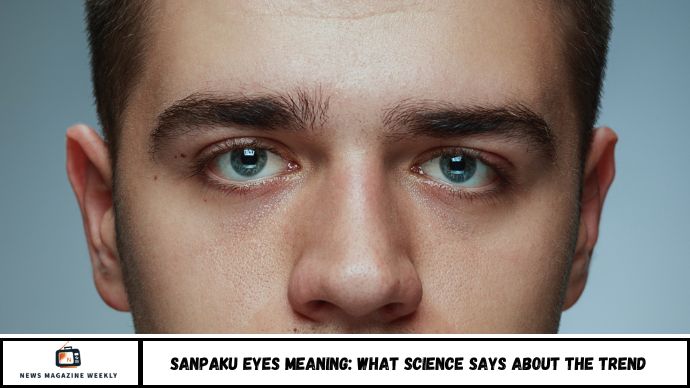Sanpaku eyes have fascinated people for decades, often linked to superstition, emotion, or fate. But what does science actually say? This article explores the biological basis of Sanpaku eyes, debunks myths, and outlines any real health implications tied to this eye feature.
Have you ever looked into someone’s eyes and noticed a sliver of white either above or below their iris? This unusual eye appearance is known as Sanpaku eyes, a term that translates from Japanese as “three whites.” Once associated with ancient Eastern beliefs—and more recently with celebrity conspiracy theories—Sanpaku eyes have sparked curiosity, superstition, and even fear.
But beyond the myths and viral social media posts, is there any science behind Sanpaku eyes? In this article, we’ll explore the origins of the term, the cultural symbolism behind it, and—most importantly—what modern medicine and research actually say about this mysterious eye trait. Whether you’re concerned about your own appearance or just intrigued by the trend, here’s what you need to know.
What Are Sanpaku Eyes?
Sanpaku (Japanese for “three whites”) describes eyes where the white part (sclera) is visible either above or below the iris. In typical eyes, the iris is centered, and white shows only on the left and right. But in Sanpaku eyes:
- Lower Sanpaku: White is visible below the iris
- Upper Sanpaku: White is visible above the iris
This condition is often highlighted in spiritual, psychological, and even conspiratorial contexts—especially in pop culture.
Where Did the Sanpaku Eye Belief Come From?
The concept gained popularity in the West in the 1960s through George Ohsawa, a Japanese macrobiotics advocate. He claimed:
- Lower Sanpaku: Signals physical imbalance or poor health
- Upper Sanpaku: Indicates mental or emotional instability
He even controversially suggested that many famous figures—like John F. Kennedy and Marilyn Monroe—had Sanpaku eyes and were “doomed.” While these claims sparked intrigue, they lack scientific backing.
What Does Science Actually Say?
From a medical standpoint, Sanpaku eyes are not a diagnosis or condition. Instead, they are simply a natural variation in eye anatomy or appearance, sometimes linked to:
- High or low eye positioning (ocular globe position)
- Facial structure and eyelid tension
- Fatigue or stress, which may cause the eyelids to droop or retract
- Medical conditions like hyperthyroidism or ptosis (rarely)
However, no peer-reviewed scientific studies support the idea that Sanpaku eyes predict personality traits, health outcomes, or fate.
Can Sanpaku Eyes Indicate a Medical Condition?
In some rare cases, excess scleral show (visible white part) may be a symptom of:
- Hyperthyroidism (Graves’ disease)
- Orbital trauma or swelling
- Neurological conditions (affecting eyelid function)
But in the vast majority of people, Sanpaku eyes are cosmetic and harmless. If sudden changes in eye appearance occur, it’s wise to consult a healthcare provider.
Cultural and Psychological Interpretations
While not rooted in science, Sanpaku eyes have been romanticized and feared in different cultural contexts:
- In Japanese and Chinese traditions, the eyes were thought to reflect inner energy or balance.
- In Western pop culture, they’ve been linked to eccentric personalities or tragedy.
- On social media platforms, Sanpaku eyes are now trending as a beauty feature, especially in celebrity close-ups.
These interpretations, while fascinating, are symbolic—not medical.
FAQs
1. Are Sanpaku eyes rare?
No. They are fairly common and often determined by genetics, eye shape, and facial structure.
2. Do Sanpaku eyes mean something bad?
Not medically. Any meaning attached is cultural or superstitious—not backed by science.
3. Can Sanpaku eyes change over time?
Yes. Fatigue, age, stress, or medical issues may affect eyelid tension and eye appearance.
4. Are Sanpaku eyes linked to mental health?
There is no scientific evidence linking Sanpaku eyes to psychological conditions.
5. Should I see a doctor for Sanpaku eyes?
Only if there’s a sudden change or if accompanied by symptoms like eye pain, swelling, or vision problems.
6. Can surgery or makeup fix Sanpaku eyes?
Cosmetic procedures can adjust eyelid positioning. Makeup can also minimize the appearance of scleral show.
Conclusion
Sanpaku eyes are a natural variation in human appearance, not a mysterious sign of destiny or danger. While ancient traditions and modern media have fueled speculation, science shows no proven link between Sanpaku eyes and health or behavior.
If your eyes appear this way, there’s no cause for concern—unless accompanied by other symptoms. Understanding the facts helps cut through the myths and focus on what really matters: your overall eye health and well-being.

